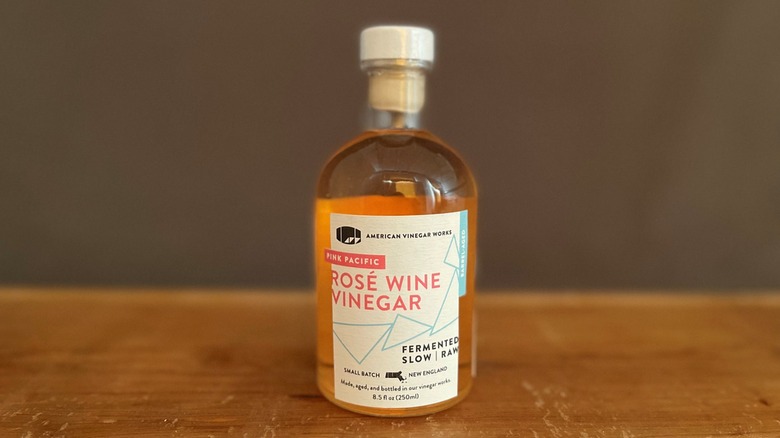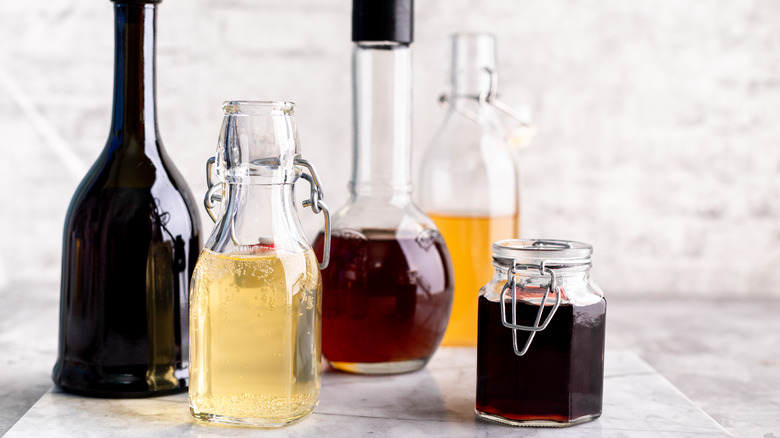How Rosé Vinegar Differs From Its Red And White Wine Counterpart
Throughout history, people have consistently found ways to produce alcohol from available resources, which also led to the — often accidental — creation of vinegar. Vinegar has been documented since at least 5000 B.C., but its name originated in 13th-century France, derived from "vin" (wine) and "aigre" (sour).
Though many types of vinegar are made from various fruits, vegetables, or grains — such as apple cider vinegar — wine vinegar is essentially wine that has fermented and turned sour. Among these, rosé wine vinegar stands out as a unique and exceptional type worth seeking. Unlike rose vinegars, which are infused with the flower, rosé wine vinegar retains the flavors of its namesake wine while transforming it into an acidic condiment. It strikes an ideal balance between the more common red wine and white wine varieties, as it is both delicate and richly flavorful, with fruit-forward notes and a light texture that can subtly liven up any dish.
Distinguishing between wine vinegars
Rosé wine vinegars are something of a hidden secret in the vinegar world. There are very few brands that make it, and it's not something you'd be able to find in your average grocery store — you're better off searching for it online. The Italian brand Ponti and the Massachusetts-based American Vinegar Works are two of the few producers trying to bring this specialized product to the masses.
Rosé vinegar is not quite as punchy as red wine vinegar, but it's a little more flavorful than white wine vinegar, and tends to have bright, fruity notes, with touches of citrus and red berries, and a hint of strawberry on the nose. It has a thin consistency, without the sediment found in apple cider vinegar, or the syrupy texture of balsamic vinegar, and its color is a clear, pretty pink.
While wine vinegars certainly don't taste exactly like the original wines they are made from, they do share some characteristics. Red wine vinegar is the closest to wine in flavor, with strong, fruity tasting notes. White wine vinegar is far more delicate, with gentle grape notes. Rosé wine vinegar lands right in the middle.
How to use rosé wine vinegar
When using wine vinegars in cooking, the common practice is to pair them as you would wine. Red wine vinegar works well in a red wine reduction sauce with red meat, or as an addition to tomato-based dishes and robust, spicy meals. On the other hand, white wine vinegar is better suited for chicken, salads, and lighter dishes.
Therefore, when using rosé vinegar, consider what you would pair with rosé wine. Seafood is an excellent choice, as are summery dishes like grilled chicken, or a light shrimp risotto or lemony pasta. Alternatively, consider using your rosé vinegar to create a vinaigrette for a salad featuring goat cheese, avocado, and grapefruit. You could also reduce the vinegar with chicken stock, crème fraîche, and butter to create a sauce for basting chicken breast. A similar sauce, enhanced with shallots and pink peppercorns, would be a superb accompaniment for seared scallops.
Rosé vinegar also shines in a spritz. It can be used in cocktails similarly to a shrub, adding a layer of brightness and acidity. You only need about a tablespoon of vinegar for four ounces of soda water and two ounces of your preferred spirit to achieve that extra zest. Picture a limoncello spritz enhanced with rosé vinegar — doesn't that sound like the most refreshing summer treat?



